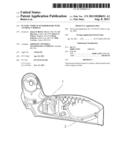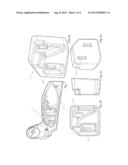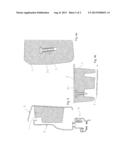Patent application title: PLASTIC VEHICLE-INTERIOR-PART WITH AN IMPACT MODULE
Inventors:
James D. Biebel (Milford, MI, US)
Ed Harrison (Canton, MI, US)
Robert E. Wilson (Brighton, MI, US)
Brian Zaharia (South Lyon, MI, US)
Mike Corvino (Canton, MI, US)
Assignees:
JOHNSON CONTROLS TECHNOLOGY COMPANY
IPC8 Class: AB60R21055FI
USPC Class:
29618703
Class name: Bodies structural detail impact
Publication date: 2013-08-08
Patent application number: 20130200651
Abstract:
The present invention relates to a plastic vehicle-interior-part with an
impact module.Claims:
1. A plastic vehicle-interior-part with an impact module, whereas the
impact module is made from an expanded plastic foam material.
2. A plastic vehicle-interior-part according to claim 1, characterized in, that the foam material is at least partially coated with a plastic material to improve the grade of the surface.
3. A plastic vehicle-interior-part according to claim 1, characterized in, that impact module is attached to the plastic vehicle-interior-part by form- and/or force-fitting-means
4. A plastic vehicle-interior-part according to claim 3, characterized in, that the thickness of the impact module has a reduced thickness in the attachment region is reduced.
5. A plastic vehicle-interior-part according to claim 3, characterized in, that the impact module comprises a slot to attach the impact module to the plastic vehicle-part.
Description:
[0001] The present invention relates to a plastic vehicle-interior-part
with an impact module.
[0002] Plastic vehicle-interior-parts often comprise impact modules, which are used as internal features to prevent excessive deflection of plastic vehicle-interior-parts, for example the valance of a vehicle seat. The impact module's functionality is, for example, to prevent the side valance from deflecting more than 10 mm when subjected to a dynamic seat belt test.
[0003] It is therefore the objective of the present invention to provide a plastic vehicle-interior-part with an impact module.
[0004] The problem is solved win a plastic vehicle-interior-part with an impact module, whereas the impact module is made from an expanded, plastic foam material.
[0005] Preferably, the expanded foam material is an expanded polypropylene. The expanded plastic foam material can he at least partially covered with a coating, preferably a plastic coating, particularly to improve the grade of the surface of the impact module.
[0006] Preferably, the impact module has a 3D-shape, whereas particularly the thickness of the impact module varies. Preferably, the shape of the impact module is adapted to the plastic vehicle-part to which it is attached. Preferably, the thickness of the impact module is reduced in its attachment region. Preferably, the impact module comprises a slot, more preferably a T-shaped slot, to attach the impact module to the plastic vehicle-part.
[0007] The impact module can be attached to the plastic part by any means known to a person skilled in the art. The impact module can be for example glued to the plastic vehicle-part. The impact module can he molded together with the plastic vehicle-part. However, preferably, the impact module is attached to the. plastic vehicle-interior-part by means of a form- and/or force-fitting-means. Preferably, there are two or more means to attach the impact module to the plastic vehicle-part. Preferably, the impact module is attached to the plastic vehicle-part-with one or more plastic barb(s).
[0008] The invention is explained in further detail according to FIGS. 1 and 3. These explanations do not limit the scope of protection.
[0009] FIG. 1 shows the vehicle-interior-part with the impact module.
[0010] FIG. 2 shows the impact module.
[0011] FIG. 3 shows the attachment of the vehicle-interior-part to a seat structure.
[0012] FIG. 4 shows the attachment of the impact module to the vehicle-interior-part.
[0013] FIG. 1 shows the incentive vehicle interior part 2, which is in the present case a side valance of a seat. Attached to this side valance 2 is an impact module 1 which is located in the area where the seat belt is fastened to the structure of the seat. The impact module 1 prevents the side valance 2 from deflecting more than 10 mm when subjected to a dynamic seat belt test (OSI2). The impact module is attached to the side valance by form- and/or force-fitting-means 2.1.
[0014] FIGS. 2a-2d show the impact module 1 in different views. As can be seen, the impact module as shaped three dimensionally and has slots 1.1 which allow a form- and/or force-fit between the impact module 1 and the side valance 2. The slot is, in the present case T-shaped, so that the form- and/or force-fitting-means 2.1 can he introduced into the slot at the top of the T and are then drawn or pushed downwards. The impact module is in the present case made from expanded polypropylene. The impact module may, at least partially, comprise a coating of its surface. In the area 1.1, where the impact module 1 is attached to the plastic vehicle-part, it preferably comprises a reduced thickness.
[0015] FIG. 3 shows the attachment/of the vehicle interior part 2 to the structure 3 of the seat. As can be seen, the side valance 2 together with the impact module 1 are attached to the side part 3 of the seat frame of a vehicle seat, which is preferably adjustable longitudinally with an upper- and a lower rail 4.
[0016] FIGS. 4a and 4b show the attachment of the impact module 1 to the side valance 2. The side valance 2 comprises form- and/or force-fitting-means here plastic barbs 2.1, which are inserted into the slots 1.1 of the impact module 1. Due to these barbs, a form- and/or a force-fit between the impact module 1 and the side valance 2 is realized. The form- and/or force-fitting-means 2.1 can be attached to the side valance 2 or the side valance 2 and the form- and/or force-fitting-means 2.1 can be provided as one piece, for example produced during one molding process.
LIST OF REFERENCE SIGNS
[0017] 1 impact module
[0018] 1.1 area of attachment, slot
[0019] 2 vehicle-interior-part, valance
[0020] 2.1 form-fitting-means, plastic barb
[0021] 3 metal structure of the seat
[0022] 4 upper-, lower-rail
User Contributions:
Comment about this patent or add new information about this topic:



